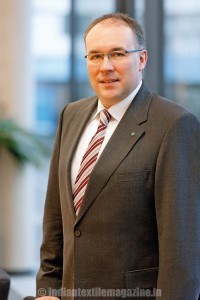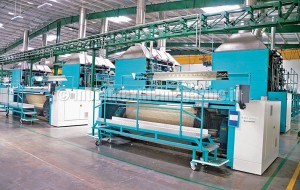In 2014 too, Karl Mayer was very active in the Indian warp knitting market with a lot of projects on hand. The company also has had ambitious plans for the future.

The exchange of information about business development and market trends was the subject of a get-together between Karl Mayer and its Indian clients at an event held in Daman recently. Roughly 120 representatives of the warp knitting sector, chiefly company owners and members of the top management, accepted the invitation of Karl Mayer and its local agent, A.T.E.
India, an important market
Arno Gärtner, Karl Mayer’s CEO, expressed his best thanks to the guests for attending this get-together. At the same time he emphasized how important it is to maintain a close contact to the customers and to understand their needs as well as the requirements of the market. In recent years the Indian market has become one of the three top markets for modern, high-technology warp knitting machines produced by Karl Mayer and LIBA, he explained. This year’s demand for tricot machines was at a consistently high level, and now there is also a growing demand for lace machines, Arno Gärtner added.
In the last few months Karl Mayer’s tricot machine sector was considerably marked by the activities for integrating the acquired company LIBA into the Karl Mayer Group, explained Oliver Mathews, Sales Vice President of the Warp Knitting Business Unit. After having analyzed the two companies’ technologies during so-called “Best of Both” projects, and after having renamed the former competitor into KARL MAYER LIBA, now there follows the restructuring of Sales and the setting up of the future product portfolio.
Consequently, the customers in India and all over the world will be able to work together with a partner who will have “one face to the customer” in terms of service, sales and technology, and who will continue to set new standards by means of increased innovative strength, stressed Oliver Mathews.
Regarding the global business with lace machines, the Sales Vice President, said: “The lace segment has been booming during the past two years, mainly due to the fashion trend in outerwear. All machine manufacturers have been busy, the main demand came from China.”
But it is evident that the lace boom is over for the time being. The high investments resulted in capacities that are more than sufficient for the current demand for lace articles. First competitors in China have already given up. But Karl Mayer is prepared for this situation: “We will undertake the necessary steps in the coming months to further strengthen our position as well as that of our loyal and long-term customers.”
Of major importance in this respect is, among other things, the new Karl Mayer factory in Ahmedabad by means of which Karl Mayer will further increase its market presence in India.
2015, an year with a lot of activities
The new modern manufacturing site in Ahmedabad will officially be opened to the public during an open house event held together with the customers on 24. April 2015. The advantages for the local knitters are short delivery times, better services, also in terms of staff training and patterning support, shorter response times to customers’ inquiries and the best possible availability of spare parts.
With this new factory Karl Mayer enhances its chances to quickly react to customers’ requests: “With A.T.E., Karl Mayer India Service and Karl Mayer Manufacturing, we will now have our presence here in India put on 3 stable legs”, explained Oliver Mathews.
The other highlights of 2015 mentioned by the Sales Vice President are the ShanghaiTex in June and the ITMA in Milan in November next – shows where Karl Mayer will be able to display its latest innovations.
“There will be plenty of news, presentations and announcements during the coming months prior to the trade fairs and almost every 3 months we will have announcements of our exhibits, new developments in all sections”, said Oliver Mathews.
Including the trade fair in Milan, it is intended to premiere 14 completely new developed machines in the course of 2015, five of which alone are designed for lace manufacturing.
